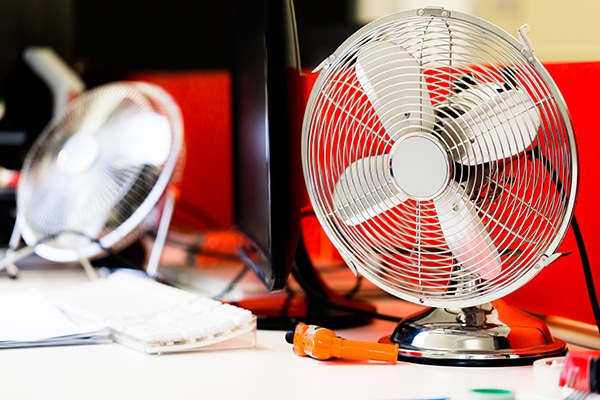According to the HSE “heat stress occurs when the body’s means of controlling its internal temperature starts to fail. As well as air temperature, factors such as work rate, humidity and clothing worn while working may lead to heat stress. Therefore, it may not be obvious to someone passing through the workplace that there is a risk of heat stress”.
For most people working in general practice heat stress is not the everyday issue it is for those who work in, for example, bakeries, compressed air tunnels, foundries or smelting operations. However, during hot spells in the summer (which, we are told, will occur more frequently and last for longer) there may be an increased risk of heat stress for some. Therefore, both employers and employees must be aware of how to be safe at work when it is hot, the factors that can lead to heat stress and how to reduce the risk of heat stress occurring.
Typical symptoms of heat stress include:
- An inability to concentrate
- Muscle cramps
- Heat rash
- Severe thirst – a late symptom of heat stress
- Fainting
- Heat exhaustion – fatigue, giddiness, nausea, headache, moist skin
- Heat stroke – hot dry skin, confusion, convulsions and eventual loss of consciousness (this is the most severe disorder and can result in death if not detected at an early stage)
It is always good practice to carry out a risk assessment for any unusual event in the surgery setting and to create a policy and procedures to cover it. So, for periods of hot weather that affect the temperature of the workplace, look at:
- Working climate – this includes air temperature, humidity, air movement and effects of working near a heat source;
- Employee clothing/uniform and any personal protective equipment required;
- An employee’s age, build and medical factors which could affect their individual heat tolerance;
- Employees’ and patients’ responses when asked how they feel (in the surgery) when it is hot to ascertain whether there are any early signs of heat stress; and
- Whether the source of the heat can be removed or reduced in any way.
As well as carrying out a risk assessment, actions should include:
- Ensuring the practice is prepared for a spell of hot weather that will raise the temperature in which the practice team are working and patients are attending.
- Controlling the temperature (functional, safe air conditioning, fans etc).
- Offering flexible working where practical or providing more rest breaks in cooler conditions.
- Preventing dehydration by providing cool water to drink in accessible places to encourage frequent hydration.
- Providing guidance on wearing PPE if this is required.
- Considering the practice dress code in relation to working in hot conditions.
- Providing training to identify the signs of heat stress and a reporting route.
- Identifying employees who are more susceptible to heat stress either because of an illness/condition or medication E.g. those with heart conditions or who are pregnant.
- Monitoring the health of employees who have been identified as at risk.
While there is no maximum temperature set out by the HSE for working conditions and, in any event, general practices do not usually operate in foundries or bakeries where it would be exceptionally hot during a spell of prolonged heat, should the CQC decide to visit your practice during hot weather, the inspection team will want to be assured that the effect of the hot conditions on patients and practice team members alike has been fully considered and all practical measures have been taken to avoid the risk of heat stress.




